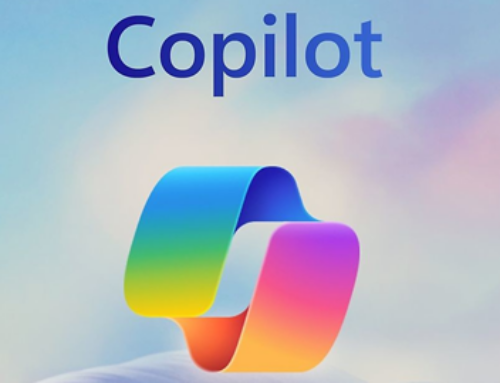Scrum Methodology Explained

What is a Scrum? What is Agile?
Have you ever been to a meeting full of professionals using buzzwords like 'Agile,' 'Scrum,' or 'Product Owner' and wondered what those terminologies are?
By definition, Agile means "able to move quickly and easily".
Agile in management is a conceptual philosophy that focuses on an iterative approach toward completing a project. Within Agile, there are many methodologies to facilitate a project, and Scrum is one of them. Project managers use Scrum to deliver the highest value to stakeholders through small iterative sprints, which usually lasts 14 days.
Before discussing if you should consider using Scrum in your organization, let's see how Scrum methodology differs from traditional project management.
Traditional vs Agile
In traditional project management, also known as waterfall project management, projects are clearly defined beforehand, focusing on formal processes and extensive documentation with minimum client involvement. Whereas, in agile project management, projects or tasks are divided into small increments of work with an interactive channel for continuous delivery and feedback, thus keeping the customer involved in every step of the process.
This chart shows how the two methods differ.
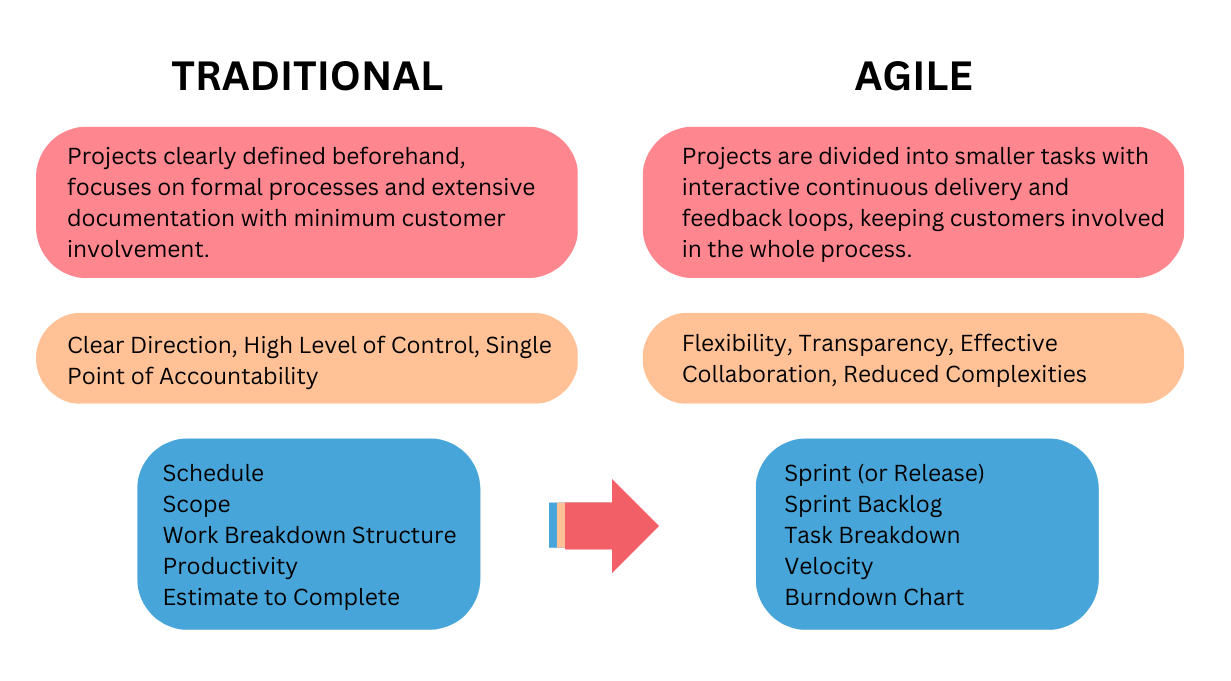
The diagram below shows the actual working of a project – as waterfall on top and as agile on the bottom. Note that in the waterfall method, the outcome or the product is available only when the project ends. Until that time there is nothing to hand over to the customer. Contrast that with the agile method where there is a product to hand over after every sprint. This product may get refined or improved in subsequent sprints but the customer has something to use sooner rather than later. This creates a minimally developed product that still meets the user requirements, thus creating value for the customer. We call this Minimum Viable Product (MVP).
An MVP provide real benefits of testing ideas quickly without heavy time and resource investments. Instead of creating all features that we think users would want, in a single iteration, we create them in phases or "sprints". With constant feedbacks from the customers, we can enhance and better shape the product. Due to this major advantage, the agile method is now more popular and is increasingly preferred by stakeholders.
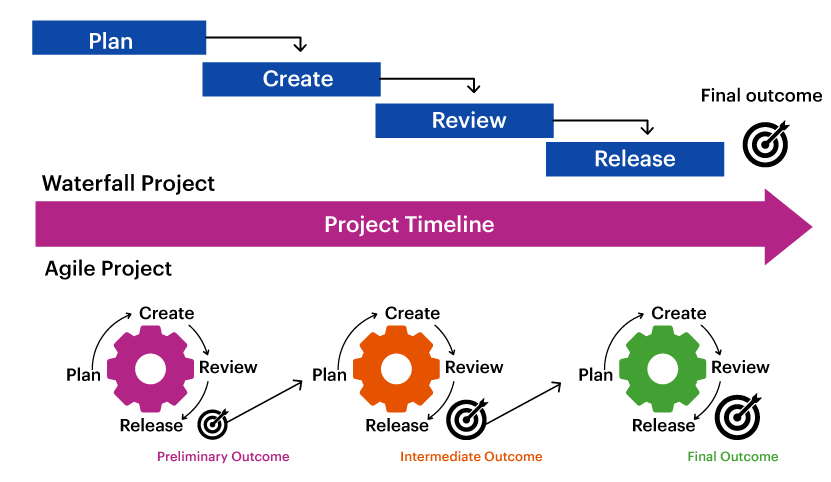
Adopting Agile
Let us now discuss how shifting from Traditional to Agile benefits your team and organization.
Personally, having worked in the industry for three years before starting my master's at Texas A&M, I have worked on multiple agile projects and interacted with various scrum entities like Scrum Master (person leading the agile team), Backlog (prioritized list of work), Product Owner (person responsible for maximizing the project outcome and ensuring Backlog is aligned with customer and stakeholder needs), and other cross-functional team members.
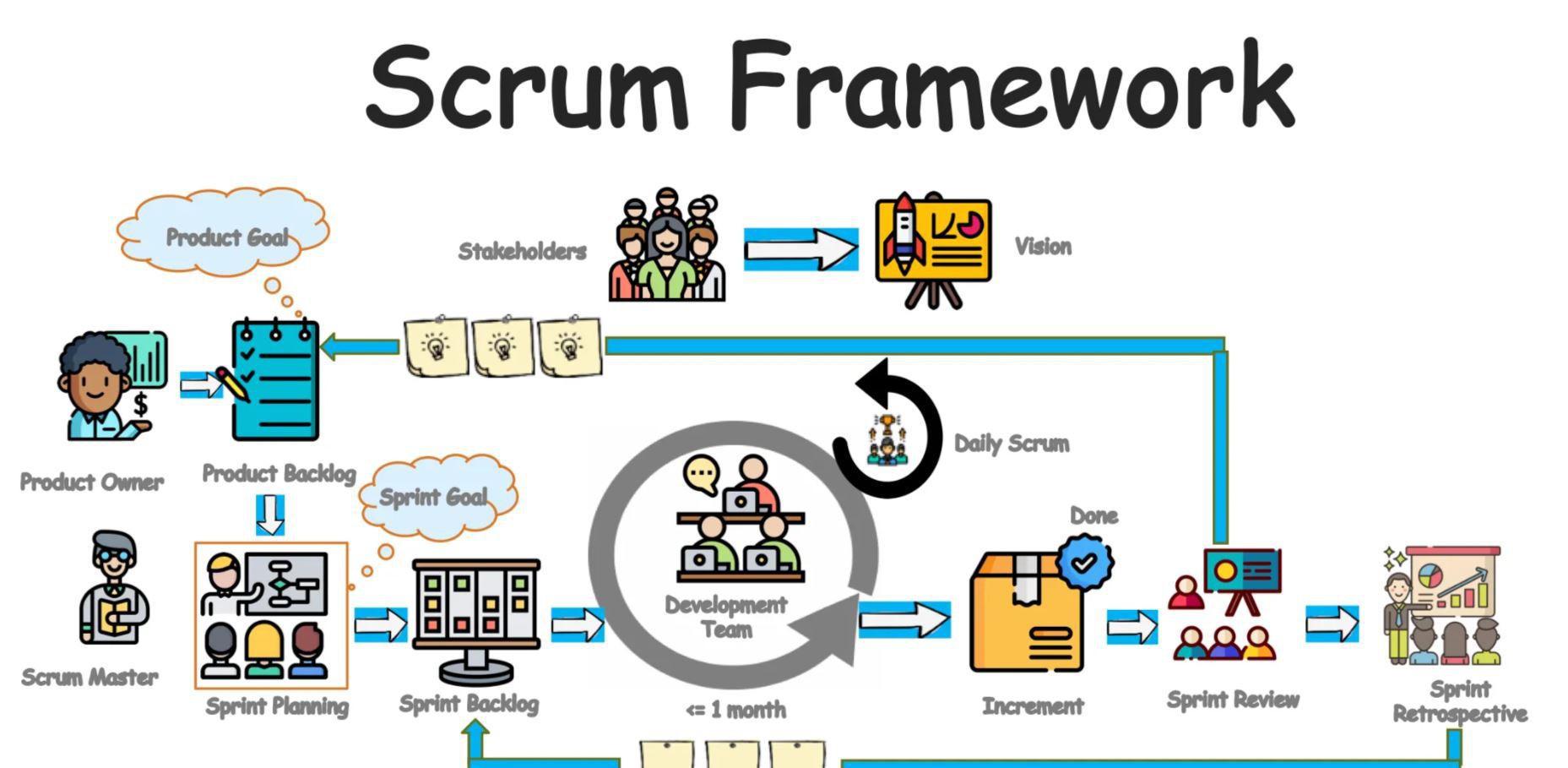
A complex project has multiple interconnected phases, with each stage depending on others rather than a single one, as in simple projects. Realistically user requirements can never be captured all at once and constantly change during the project life cycle.
During project development, if any new requirement needs to be addressed immediately, affecting the ongoing sprint, the Product Owner terminates that sprint after the stakeholder's approval. Once terminated, the sprint is re-planned and relaunched, incorporating these new requirements.
In situations where the new change is minor with low priority, that change is added to the Product Backlog and later incorporated into future sprint planning. This allowed the stakeholders to respond to external environment changes and simultaneously maintain control over ongoing activities within the project. Teams achieve the benefits of flexibility, transparency, reduced complexity, and effective collaboration by utilizing agile framework principles.
Similarly, by transitioning to agile methodology, your organization or team can reap such benefits, improving management skills and creating higher-value products for the business.
Making Texas A&M Agile
Texas A&M University holds many departments within it, and each one can leverage the Agile framework in its projects. To better illustrate it, let us take an example of how departments like Recreation Sports and Residence Life can use Agile.
Here we consider a hypothetical project Residence Life may consider to improve its services. Offering students the ability to request for a Room Change Request in the on-campus housing facilities is an integral part of the Residence Life department. In case Residence Life wants to launch a refreshed Room Change Request process using Scrum and Agile – this is how they would go about doing it.
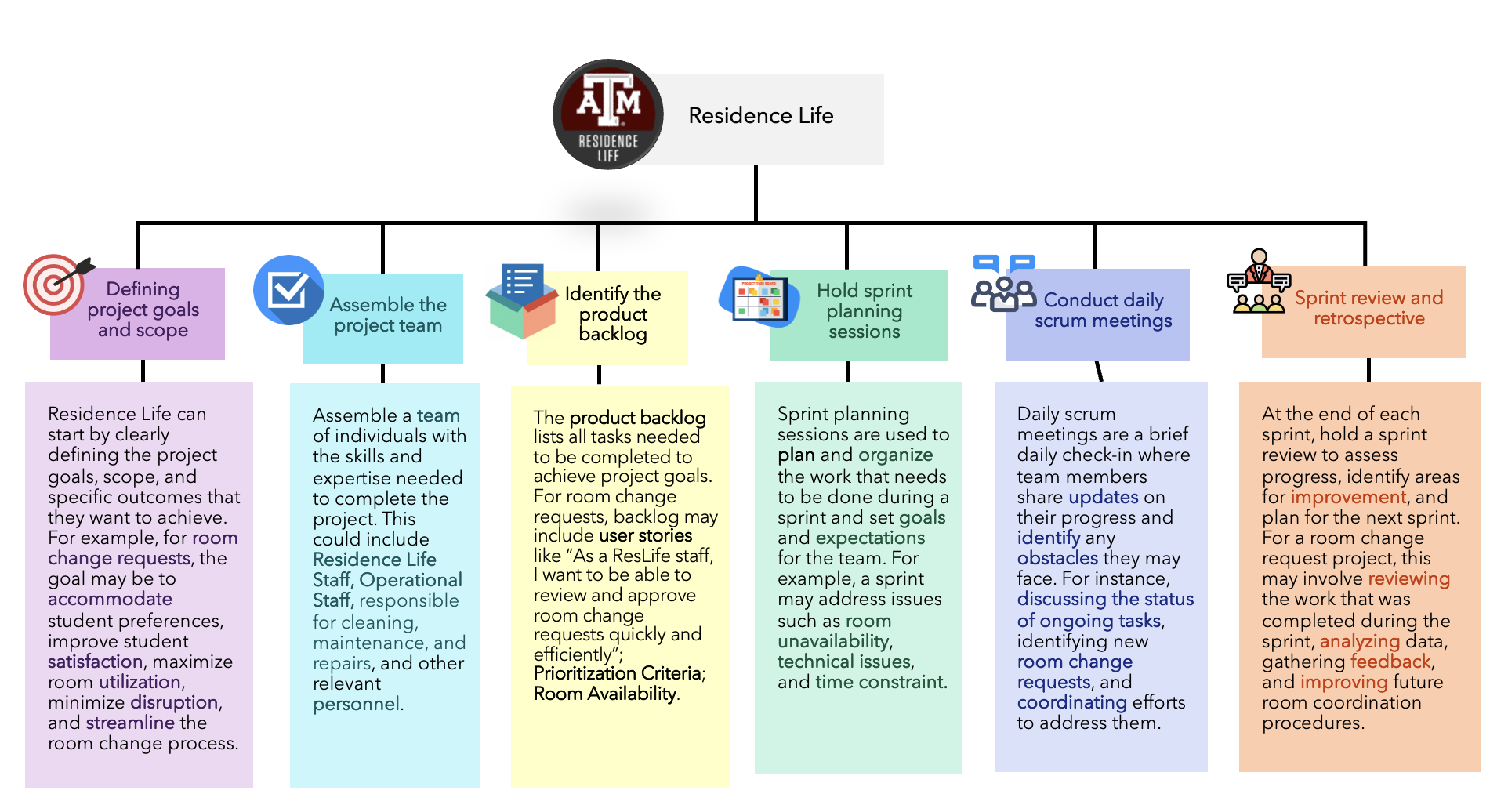
Similarly, the Department of Recreation Sports can adopt Scrum/Agile principles in its initiatives, such as launching a new fitness program for students and employees.

Free Training Resources
Now if you have decided to dive deeper into Scrum, I have listed some great free resources that will help you explore Scrum further and master it.
- Official Scrum guide – Scrum Guide by Ken Schwaber and Jeff Sutherland, the originators of Scrum.
- Open Assessments – Official free study tool to gauge your basic Scrum knowledge, Scrum accountabilities, and the fundamentals of Scrum teams and structure.
- Nexus Guide – Introduces you to the framework for scaling Scrum by minimizing cross-team dependencies and integration issues.
- Scrum for Beginners + Scrum Master Certification Preparation – Introductory course to Agile and Scrum with free practice sets. Help you prepare for your Scrum Master or Agile certification based on the Scrum Guide™ v2020
- Scrum Master learning path – The Scrum Master learning path provides a structured guide to help you understand the role of the Scrum Master with an organized set of scrum competencies, each containing several focus areas.
- Agile with Atlassian Jira – This course discusses common foundational principles and practices used by agile methodologies. It takes you further and teaches you how to apply agile practices in Jira Software Cloud and how to create and manage agile boards.
- LinkedIn Learning– Linkedin Learning course for beginners. It builds the basic understanding of what scrum is and how you can start implementing it at work. It covers topics like establishing scrum team, writing user stories, and setting vision for your project.
What is better than experiencing a Scrum or Sprint meeting first-hand? If you are curious to know what it looks like in the real world, you are welcome to come and see a Sprint firsthand. You can reach out to Donald St. Martin at: [email protected] to let him know your interest and schedule a visit.
Getting Scrum Certified
Once you understand the Scrum benefits and plan to transition to it, getting certified by the official Scrum organization is the ideal next step. To begin with, there are many industry-recognized Scrum certifications like Certified ScrumMaster (CSM), Certified Scrum Product Owner (CSPO), Professional Scrum Master (PSM I), and Certified Scrum Professional (CSP).
I personally decided to go for the Professional Scrum Master (PSM I), an entry-level certification offered by Scrum.org, costing $150. Taking the certification has solidified my knowledge of Scrum as an Agile practice and here are the top reasons why I recommend taking the certification.
- Effectively Use Scrum: No matter your expertise in project management, a certification will grow your knowledge of Scrum terminology, practices, and principles, enabling you to overcome obstacles and manage large teams across multiple departments using a single framework.
- Liberate Mindset: Having an agile mindset is vital to achieving sustainable organizational goals. Industry-oriented certification will inculcate agile thinking, leading to efficient teamwork, lesser team disagreements, and more successful projects.
- Career Boost: Since the agile methodology is applicable across all disciplines, getting certified provides employers tangible proof that you possess the skills of a manager and are well-equipped for the job. It also serves as a differentiator showing potential employers that you have the edge over your counterparts.
- Leadership and Collaboration: A Scrum Master who is certified holds the credibility of a reliable leader who can guide the team toward creating sustainable products and help the team work together smoothly.
Agile teams need Scrum leaders who can provide expertise far beyond the capacity of a typical project manager. If you decide to be a Scrum leader register for Scrum Master CSM certification and take the next steps down an exciting and rewarding career.


